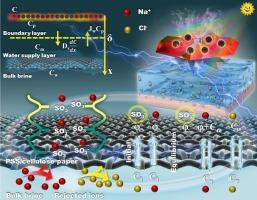Jellyfish–mimetic solar evaporator with polyelectrolyte skeleton for sustainable desalination under higher salinity
IF 9.8
1区 工程技术
Q1 ENGINEERING, CHEMICAL
引用次数: 0
Abstract
Photothermal membranes have seen significant advancements in the field of solar seawater desalination. However, their practical application is hindered by solid-salt crystallization, which results in reduced evaporation rates. Herein, an “all–in–one” anionic jellyfish–mimetic solar evaporator is reported with sustainable condensate yields and electrostatic repulsion to prevent solid–salt crystallization. The innovative structure is composed of the jellyfish–mimetic photothermal head (in–situ grown nanospheres of Prussian blue analogue and molybdenum disulfide (PBA@MoS2)) while polyelectrolyte legs (water channels) enriched with SO3− groups by polystyrene sodium sulfonate (PSS). The negatively charged evaporator was characterized by a high concentration of SO3−, which induces the Donnan effect by confining Na+ to the microchannels. This process reduces the diffusion of salt ions into the water supply layer, thereby addressing the issue of salt deposition at its fundamental level. As a result, a high evaporation rate of 1.89 kg m−2 h−1 was achieved in high–concentration brine (20 wt% NaCl) under one sun irradiation. More importantly, the evaporator achieves high condensate yields (15.7 g/10 h) under natural sunlight and demonstrates excellent reproducibility in evaporation rates over 20 performance cycles on different days, even with a salinity of 20 wt%. The efficient evaporation efficiency and high salt tolerance present significant practical potential for solar–driven seawater desalination.

具有聚电解质骨架的水母模拟太阳能蒸发器,用于在较高盐度条件下实现可持续海水淡化
光热膜在太阳能海水淡化领域取得了重大进展。然而,它们的实际应用受到固盐结晶的阻碍,导致蒸发率降低。本文报告了一种 "一体化 "阴离子水母模拟太阳能蒸发器,它具有可持续的冷凝水产量和防止固盐结晶的静电排斥力。这种创新结构由水母模拟光热头(原位生长的普鲁士蓝类似物和二硫化钼纳米球(PBA@MoS2))和聚苯乙烯磺酸钠(PSS)富含 SO3-基团的聚电解质腿(水通道)组成。带负电的蒸发器具有高浓度 SO3- 的特点,它通过将 Na+ 限制在微通道内而诱发唐南效应。这一过程减少了盐离子向供水层的扩散,从而从根本上解决了盐沉积问题。因此,在一个太阳照射下,高浓度盐水(20 wt% NaCl)的蒸发率高达 1.89 kg m-2 h-1。更重要的是,该蒸发器在自然日照条件下实现了较高的冷凝物产量(15.7 克/10 小时),并在不同天数的 20 个性能循环中表现出极佳的蒸发率再现性,即使盐度为 20 wt%。高效的蒸发效率和高耐盐性为太阳能驱动的海水淡化带来了巨大的实用潜力。
本文章由计算机程序翻译,如有差异,请以英文原文为准。
求助全文
约1分钟内获得全文
求助全文
来源期刊

Desalination
工程技术-工程:化工
CiteScore
14.60
自引率
20.20%
发文量
619
审稿时长
41 days
期刊介绍:
Desalination is a scholarly journal that focuses on the field of desalination materials, processes, and associated technologies. It encompasses a wide range of disciplines and aims to publish exceptional papers in this area.
The journal invites submissions that explicitly revolve around water desalting and its applications to various sources such as seawater, groundwater, and wastewater. It particularly encourages research on diverse desalination methods including thermal, membrane, sorption, and hybrid processes.
By providing a platform for innovative studies, Desalination aims to advance the understanding and development of desalination technologies, promoting sustainable solutions for water scarcity challenges.
 求助内容:
求助内容: 应助结果提醒方式:
应助结果提醒方式:


